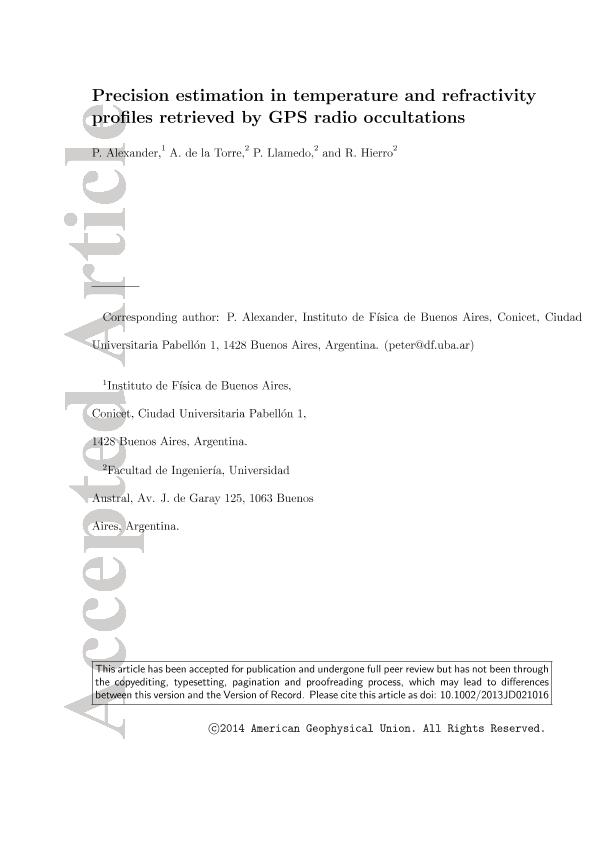Mostrar el registro sencillo del ítem
dc.contributor.author
Alexander, Pedro Manfredo

dc.contributor.author
de la Torre, Alejandro

dc.contributor.author
Llamedo Soria, Pablo Martin

dc.contributor.author
Hierro, Rodrigo Federico

dc.date.available
2017-06-15T15:46:29Z
dc.date.issued
2014-07
dc.identifier.citation
Alexander, Pedro Manfredo; de la Torre, Alejandro; Llamedo Soria, Pablo Martin; Hierro, Rodrigo Federico; Precision estimation in temperature and refractivity profiles retrieved by GPS radio occultations; American Geophysical Union; Journal Of Geophysical Research; 119; 14; 7-2014; 8624-8638
dc.identifier.issn
0148-0227
dc.identifier.uri
http://hdl.handle.net/11336/18241
dc.description.abstract
The Constellation Observing System for Meteorology Ionosphere and Climate (COSMIC) is a six-satellite Global Positioning System (GPS) radio occultation (RO) mission that started in April 2006. The close proximity of these satellites during some months after launch provided a unique opportunity to evaluate the precision of GPS RO temperature and refractivity profile retrievals in the neutral atmosphere from nearly collocated and simultaneous observations. In order to work with nearly homogeneous sets, data are divided into five groups according to latitude bands during 20 days of July. For all latitude bands and variables, the best precision values (about 0.1%) are found somewhere between 8 and 25 km height. In general, we find that precision degrades significantly with height above 30 km and its performance becomes there worse than 1%. Temperature precision assessment has been generally excluded in previous studies. Refractivity has here, in general, a precision similar to dry temperature but worse than wet temperature in the lower atmosphere and above 30 km. However, it has been shown that the better performance of wet temperature is an artificial effect produced by the use of the same background information in nearly collocated wet retrievals. Performance in refractivity around 1% is found in the Northern Hemisphere at the lowest heights and significantly worse in the southern polar zone above 30 km. There is no strong dependence of the estimated precision in terms of height on day and night, on latitude, on season, or on the homogeneity degree of each group of profiles. This reinforces the usual claim that GPS RO precision is independent of the atmospheric conditions. The roughly 0.1% precision in the 8–25 km height interval should suffice to distinguish between day and night average values, but no significant differences are found through a Student t test for both populations at all heights in each latitude band. It was then shown that the present spatial density of GPS RO does not allow to analyze smaller latitudinal bands, which could lead to smaller dispersions associated with the day and night means, where it would then be potentially possible to detect significant statistical differences among both categories. We studied the uncertainties associated with the background conditions used in the retrievals and found that their contribution is negligible at all latitudes and heights. However, they force an artificial improvement of wet temperature precision as compared to the dry counterpart at the lowest and highest altitudes studied. In addition, we showed that there is no detectable dubious behavior of COSMIC data prior to day 194 of year 2006 as warned by the data providers, but our result applies only to the precision issue and cannot be extended to other features of data quality. Regarding accuracy, we estimated an average bias of 0.1 K for GPS RO temperature between about 10 and 30 km height and somewhat larger at lower altitudes. We expect a roughly −0.5 K bias above 35 km altitude. Regarding refractivity, a −0.2% bias of the measurements was estimated below about 8 km height.
dc.format
application/pdf
dc.language.iso
eng
dc.publisher
American Geophysical Union

dc.rights
info:eu-repo/semantics/openAccess
dc.rights.uri
https://creativecommons.org/licenses/by-nc-sa/2.5/ar/
dc.subject
Precision
dc.subject
Temperature
dc.subject
Refractivity
dc.subject
Radio Occultation
dc.subject.classification
Meteorología y Ciencias Atmosféricas

dc.subject.classification
Ciencias de la Tierra y relacionadas con el Medio Ambiente

dc.subject.classification
CIENCIAS NATURALES Y EXACTAS

dc.title
Precision estimation in temperature and refractivity profiles retrieved by GPS radio occultations
dc.type
info:eu-repo/semantics/article
dc.type
info:ar-repo/semantics/artículo
dc.type
info:eu-repo/semantics/publishedVersion
dc.date.updated
2017-06-12T18:05:35Z
dc.journal.volume
119
dc.journal.number
14
dc.journal.pagination
8624-8638
dc.journal.pais
Estados Unidos

dc.journal.ciudad
Washington DC
dc.description.fil
Fil: Alexander, Pedro Manfredo. Consejo Nacional de Investigaciones Científicas y Técnicas. Oficina de Coordinación Administrativa Ciudad Universitaria. Instituto de Física de Buenos Aires. Universidad de Buenos Aires. Facultad de Ciencias Exactas y Naturales. Instituto de Física de Buenos Aires; Argentina
dc.description.fil
Fil: de la Torre, Alejandro. Consejo Nacional de Investigaciones Científicas y Técnicas; Argentina. Universidad Austral. Facultad de Ingeniería; Argentina
dc.description.fil
Fil: Llamedo Soria, Pablo Martin. Consejo Nacional de Investigaciones Científicas y Técnicas; Argentina. Universidad Austral. Facultad de Ingeniería; Argentina
dc.description.fil
Fil: Hierro, Rodrigo Federico. Consejo Nacional de Investigaciones Científicas y Técnicas; Argentina. Universidad Austral. Facultad de Ingeniería; Argentina
dc.journal.title
Journal Of Geophysical Research

dc.relation.alternativeid
info:eu-repo/semantics/altIdentifier/doi/http://dx.doi.org/10.1002/2013JD021016
dc.relation.alternativeid
info:eu-repo/semantics/altIdentifier/url/http://onlinelibrary.wiley.com/doi/10.1002/2013JD021016/abstract
Archivos asociados
